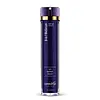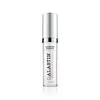What's inside
What's inside
 Key Ingredients
Key Ingredients

 Benefits
Benefits

 Concerns
Concerns

 Ingredients Side-by-side
Ingredients Side-by-side

Water
Skin ConditioningCyclopentasiloxane
EmollientGlycerin
HumectantNiacinamide
SmoothingSinorhizobium Meliloti Ferment Filtrate
Skin ConditioningOctyldodecanol
EmollientDimethicone
EmollientPolysorbate 20
EmulsifyingDimethicone/Vinyl Dimethicone Crosspolymer
Skin ConditioningLauryl PEG-9 Polydimethylsiloxyethyl Dimethicone
Skin ConditioningAmmonium Acryloyldimethyltaurate/Vp Copolymer
Phospholipids
Skin ConditioningSh-Oligopeptide-5 Sp
BleachingSh-Oligopeptide-102 Sp
Skin ConditioningPalmitoyl Tripeptide-38
Skin ConditioningSodium Hyaluronate
HumectantArabidopsis Thaliana Extract
AntioxidantRibes Nigrum Seed Oil
EmollientHelianthus Annuus Seed Oil Unsaponifiables
EmollientCardiospermum Halicacabum Flower/Leaf/Vine Extract
Skin ConditioningErgothioneine
AntioxidantRosmarinus Officinalis Leaf Extract
AntimicrobialHelianthus Annuus Seed Oil
EmollientTocopheryl Acetate
AntioxidantUbiquinone
AntioxidantLeuconostoc/Radish Root Ferment Filtrate
AntimicrobialTocopherol
AntioxidantEpigallocatechin Gallatyl Glucoside
AntioxidantSerum Albumin
HumectantAlanyl Glutamine
HumectantCetyl Hydroxyethylcellulose
Emulsion StabilisingLecithin
EmollientHydroxypropyl Cyclodextrin
MaskingPhytic Acid
Phenoxyethanol
PreservativeCaprylyl Glycol
EmollientEthylhexylglycerin
Skin ConditioningHexylene Glycol
EmulsifyingSodium Chloride
MaskingWater, Cyclopentasiloxane, Glycerin, Niacinamide, Sinorhizobium Meliloti Ferment Filtrate, Octyldodecanol, Dimethicone, Polysorbate 20, Dimethicone/Vinyl Dimethicone Crosspolymer, Lauryl PEG-9 Polydimethylsiloxyethyl Dimethicone, Ammonium Acryloyldimethyltaurate/Vp Copolymer, Phospholipids, Sh-Oligopeptide-5 Sp, Sh-Oligopeptide-102 Sp, Palmitoyl Tripeptide-38, Sodium Hyaluronate, Arabidopsis Thaliana Extract, Ribes Nigrum Seed Oil, Helianthus Annuus Seed Oil Unsaponifiables, Cardiospermum Halicacabum Flower/Leaf/Vine Extract, Ergothioneine, Rosmarinus Officinalis Leaf Extract, Helianthus Annuus Seed Oil, Tocopheryl Acetate, Ubiquinone, Leuconostoc/Radish Root Ferment Filtrate, Tocopherol, Epigallocatechin Gallatyl Glucoside, Serum Albumin, Alanyl Glutamine, Cetyl Hydroxyethylcellulose, Lecithin, Hydroxypropyl Cyclodextrin, Phytic Acid, Phenoxyethanol, Caprylyl Glycol, Ethylhexylglycerin, Hexylene Glycol, Sodium Chloride
Cyclopentasiloxane
EmollientDimethicone Crosspolymer
Emulsion StabilisingPentaerythrityl Tetraisostearate
EmollientHeptyl Undecylenate
EmollientGlycine Soja Oil
EmollientPanthenyl Triacetate
Palmitoyl Tripeptide-1
Skin ConditioningPalmitoyl Hexapeptide-12
Skin ConditioningNaringenin
Skin ConditioningOleuropein
AntioxidantOlea Europaea Leaf Extract
PerfumingPhosphatidylserine
Emulsion StabilisingArnica Montana Extract
Skin ConditioningPhospholipids
Skin ConditioningDunaliella Salina Extract
Skin ConditioningTocopherol
AntioxidantAscorbyl Palmitate
AntioxidantSqualane
EmollientCaprylic/Capric Triglyceride
MaskingCaprylyl Methicone
Skin ConditioningPropylene Carbonate
SolventStearalkonium Hectorite
Gel FormingCyclopentasiloxane, Dimethicone Crosspolymer, Pentaerythrityl Tetraisostearate, Heptyl Undecylenate, Glycine Soja Oil, Panthenyl Triacetate, Palmitoyl Tripeptide-1, Palmitoyl Hexapeptide-12, Naringenin, Oleuropein, Olea Europaea Leaf Extract, Phosphatidylserine, Arnica Montana Extract, Phospholipids, Dunaliella Salina Extract, Tocopherol, Ascorbyl Palmitate, Squalane, Caprylic/Capric Triglyceride, Caprylyl Methicone, Propylene Carbonate, Stearalkonium Hectorite
 Reviews
Reviews

Alternatives
Ingredients Explained
These ingredients are found in both products.
Ingredients higher up in an ingredient list are typically present in a larger amount.
Cyclopentasiloxane, or D5, is a silicone used to improve texture of products and trap moisture.
D5 is considered lightweight and volatile. Volatile means it evaporates quickly after application. Once evaporated, D5 leaves a thin barrier that helps keep skin hydrated.
It is also an emollient. Emollients help soften the skin and prevent water loss. Silicones create a silky texture in products. D5 helps other ingredients become more spreadable.
Studies show D5 is safe to use in skincare products. We recommend speaking with a skincare professional if you have concerns.
Learn more about CyclopentasiloxanePhospholipids are naturally found in our skin as they are the main component of cell membranes. Phospholipids have humectant, emollient, antioxidant properties.
Phospholipids are complex lipids that contain glycerin, two fatty acids, and a phosphate group. Some foods that contain phospholipids include soybeans and milk. The phospholipids found in soy come from Lecithin. This ingredient can also be synthetically created.
Due to their hygroscopic nature, they act as both humectants and emollients. Humectants draw moisture from the air to your skin, while emollients help trap moisture in.
The phospholipids in our skin can be naturally depleted. Replenishing the phospholipids in our skin can help hydrate your skin.
Studies show phospholipids display antioxidant activity and may help with reducing the signs of aging.
This ingredient is non-occlusive.
Some types of phospholipids:
Learn more about PhospholipidsTocopherol (also known as Vitamin E) is a common antioxidant used to help protect the skin from free-radicals and strengthen the skin barrier. It's also fat soluble - this means our skin is great at absorbing it.
Vitamin E also helps keep your natural skin lipids healthy. Your lipid skin barrier naturally consists of lipids, ceramides, and fatty acids. Vitamin E offers extra protection for your skin’s lipid barrier, keeping your skin healthy and nourished.
Another benefit is a bit of UV protection. Vitamin E helps reduce the damage caused by UVB rays. (It should not replace your sunscreen). Combining it with Vitamin C can decrease sunburned cells and hyperpigmentation after UV exposure.
You might have noticed Vitamin E + C often paired together. This is because it is great at stabilizing Vitamin C. Using the two together helps increase the effectiveness of both ingredients.
There are often claims that Vitamin E can reduce/prevent scarring, but these claims haven't been confirmed by scientific research.
Learn more about Tocopherol